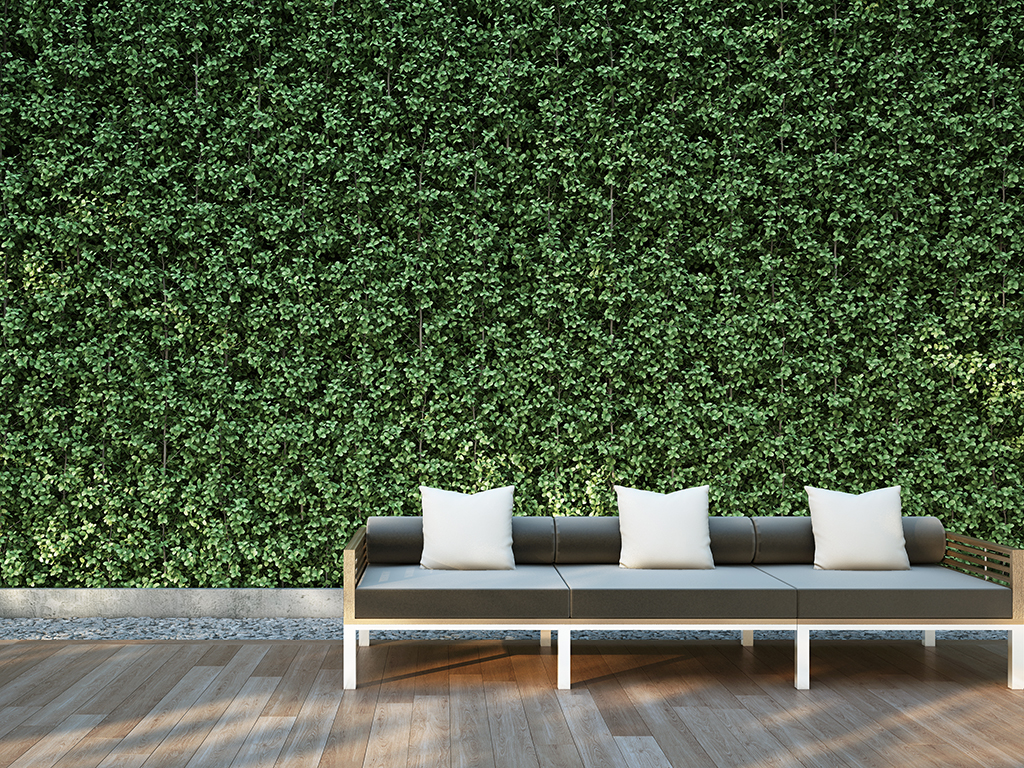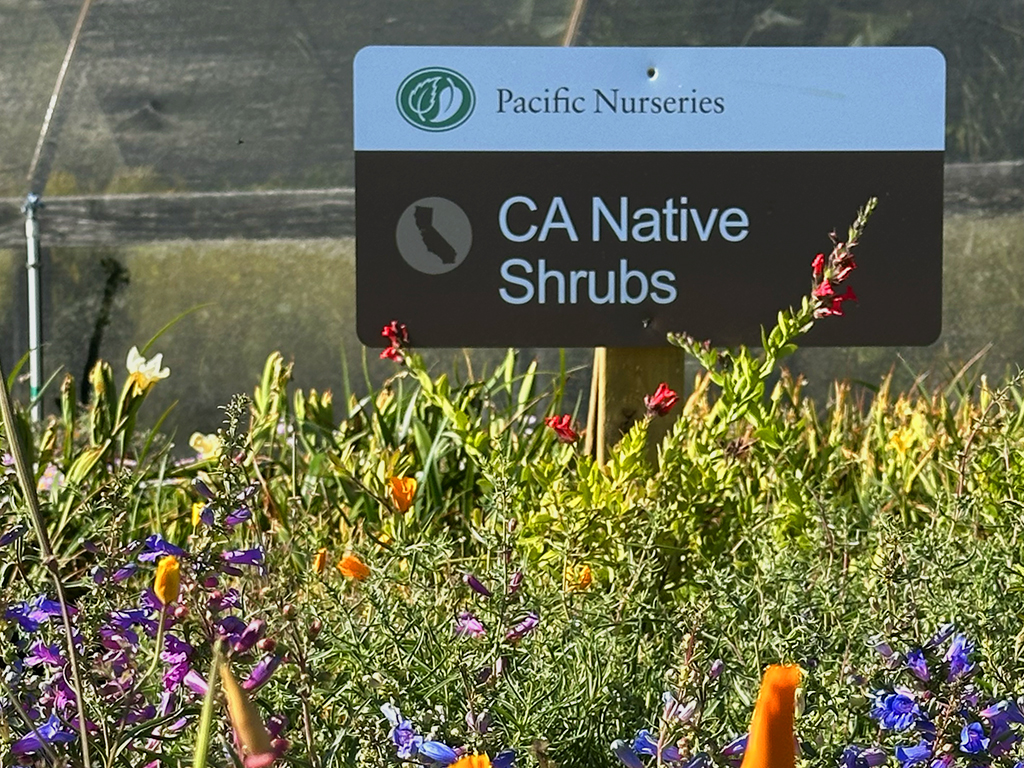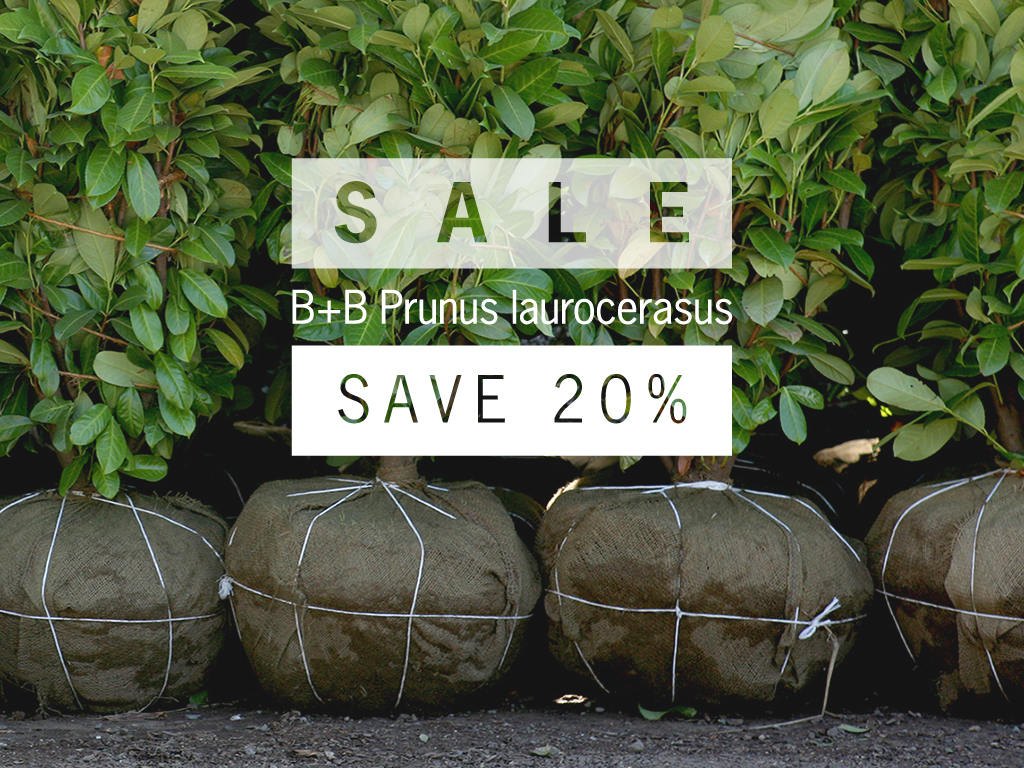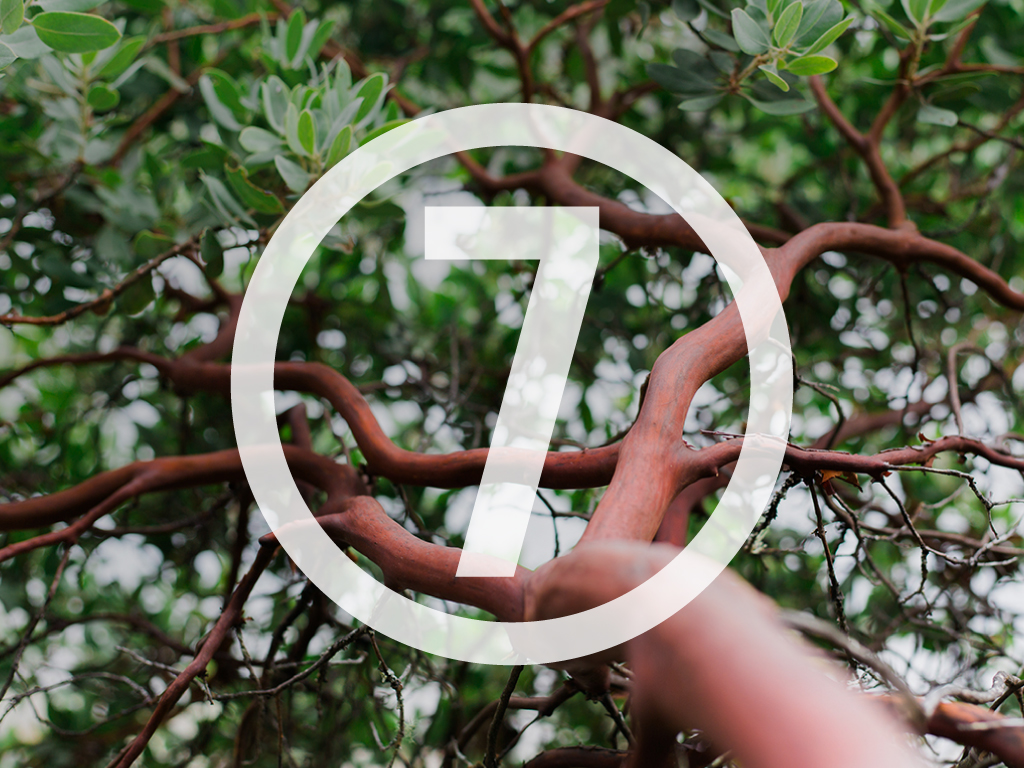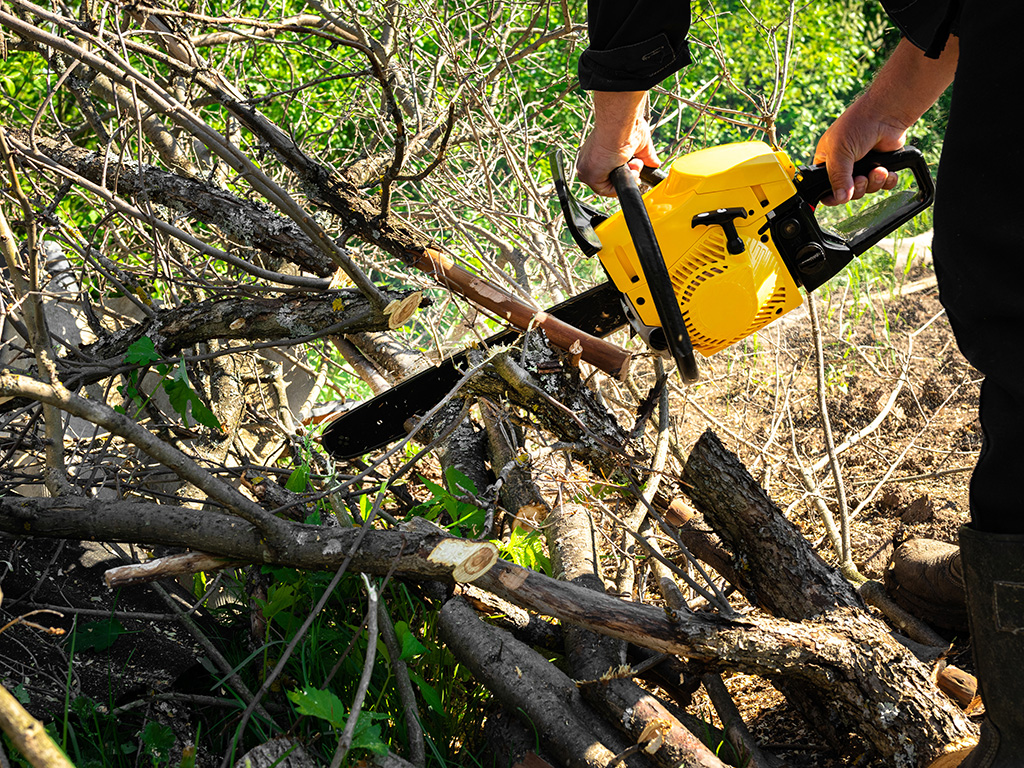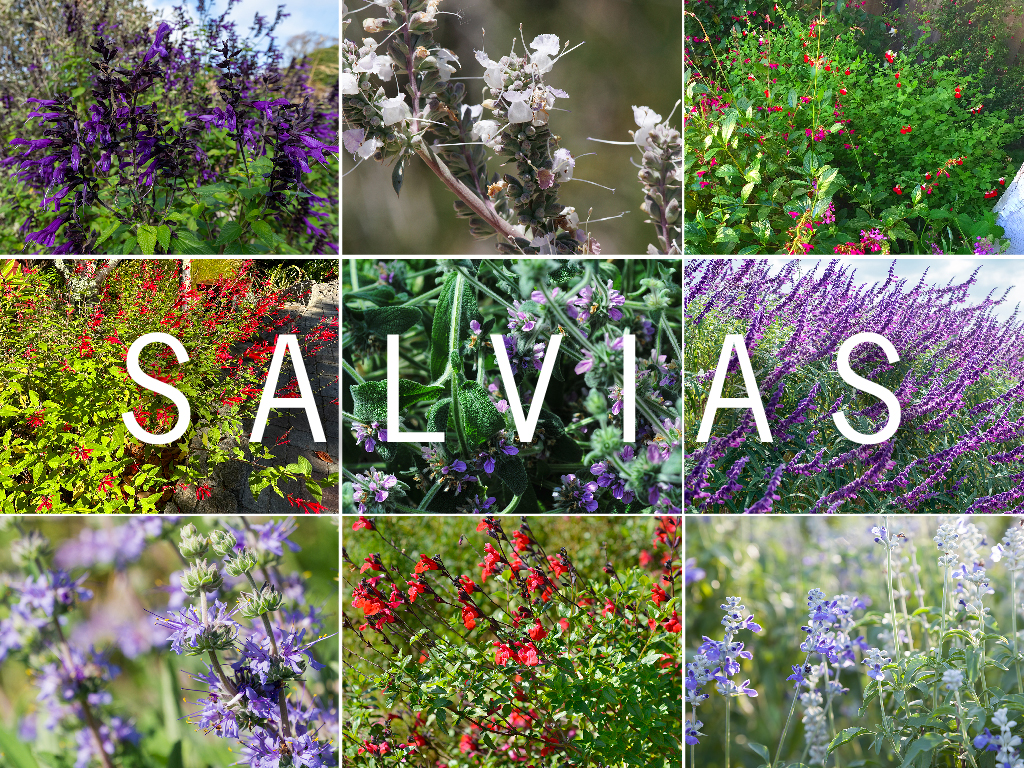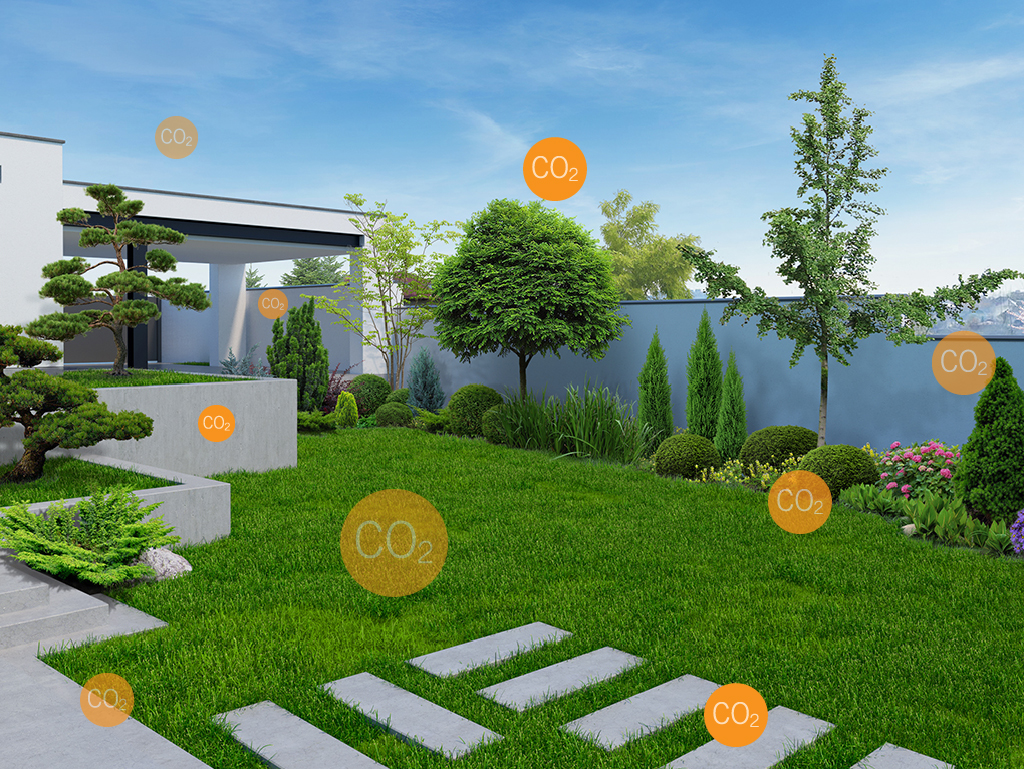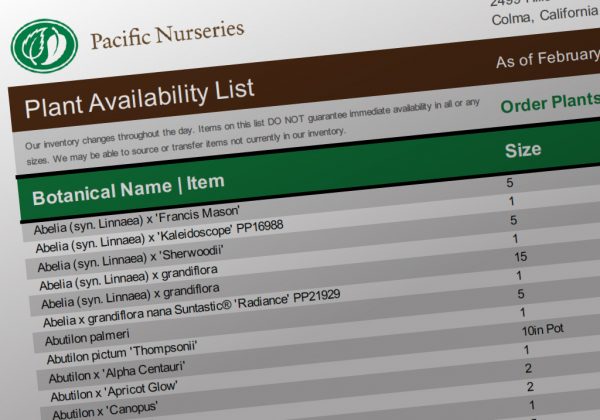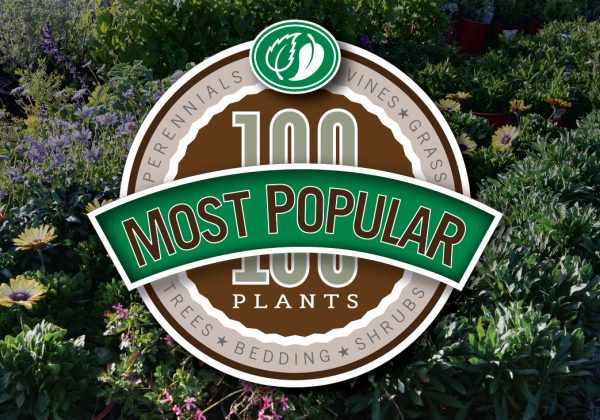Many Landscape Pro customers are asking for help to create beautiful garden space retreats that can provide a break from the growing congestion in the Bay Area.
They’re also looking for guidance on how to improve privacy with beautiful hedge and screen plants.
As a result, more and more of your customers want to mitigate the feeling that neighbors are getting a little too close.
As a result, more and more of your customers want to mitigate the feeling that neighbors are getting a little too close.
Privacy and beauty are within reach
Using plants in your landscape design to create and integrate more privacy is something to consider. Incorporating hedge or barrier plants with great texture, form, and color into a successful landscape design involves more than simply arranging plants in a row.When done well, a living hedge or integrated privacy solution can provide calming solitude in a garden. It can also deliver many ecological and aesthetic benefits including:
- Define property lines
- Highlight paths + walkways
- Direct attention to a garden component
- Provide ideal bird habitat
- Reduce noise + dust pollution
- Attract pollinators
- Sequester carbon
- Enhance architecture
- And much more
Choosing the right plants for their horticultural and practical properties to provide privacy can also increase the value of just about any landscape environment.
How to choose the right plants for a privacy screen
With so many options to choose from, how do you choose the right plants for a hedge or privacy screen?A good place to start is considering plants that have these attributes:
Dense foliage
Moderate growth
Medium size
Water-wise
CA Native
Your choice of plants should be guided by the style and aesthetics of the hedge that you or your client is looking for.
Like trees, hedges can provide dense shade that can cool areas that have heavy sun exposure. Planting a hedge can also improve both the attractiveness and function of a garden area.
Like trees, hedges can provide dense shade that can cool areas that have heavy sun exposure. Planting a hedge can also improve both the attractiveness and function of a garden area.
Hedge and screen plant guidelines to consider
We recommend choosing hearty, pest and disease-resistant plants that suit your climate and specific garden conditions. It’s also important to make plant choices that are low maintenance. Slow and moderate growing plants may fare better in many situations as rapid growers will require more frequent upkeep after installation.Because a hedge is a living barrier that grows, you can accommodate tighter budgets by integrating smaller specimens and letting time work to your advantage. With a little extra patience and care, nurturing smaller shrubs into a big, beautiful hedge can be both economical and visually rewarding.
Here are some helpful guidelines for plant growth:
If you’re considering a sculpted, formal hedge, recognize that it will need regular maintenance and clipping. And if you’re thinking about a more natural, less formal design, your maintenance requirements may be no more than annual pruning.
Consider mature height of hedge and screen plants
Formal hedges, with a solid architectural form, can frame a garden or create individual rooms or sections within it.You can also use flowering plants of various heights to create a hedge or privacy screen with an informal layered effect. Flowering shrubs can also create a visually attractive, aromatic, and green barrier that an ordinary fence could never replicate.
One of the most important attributes to consider for your hedge is the mature height of the plants that you’ll be using. Choose wisely as plants that aren’t tall enough to screen for privacy or that are too tall for a location could be a disappointment to your clients.
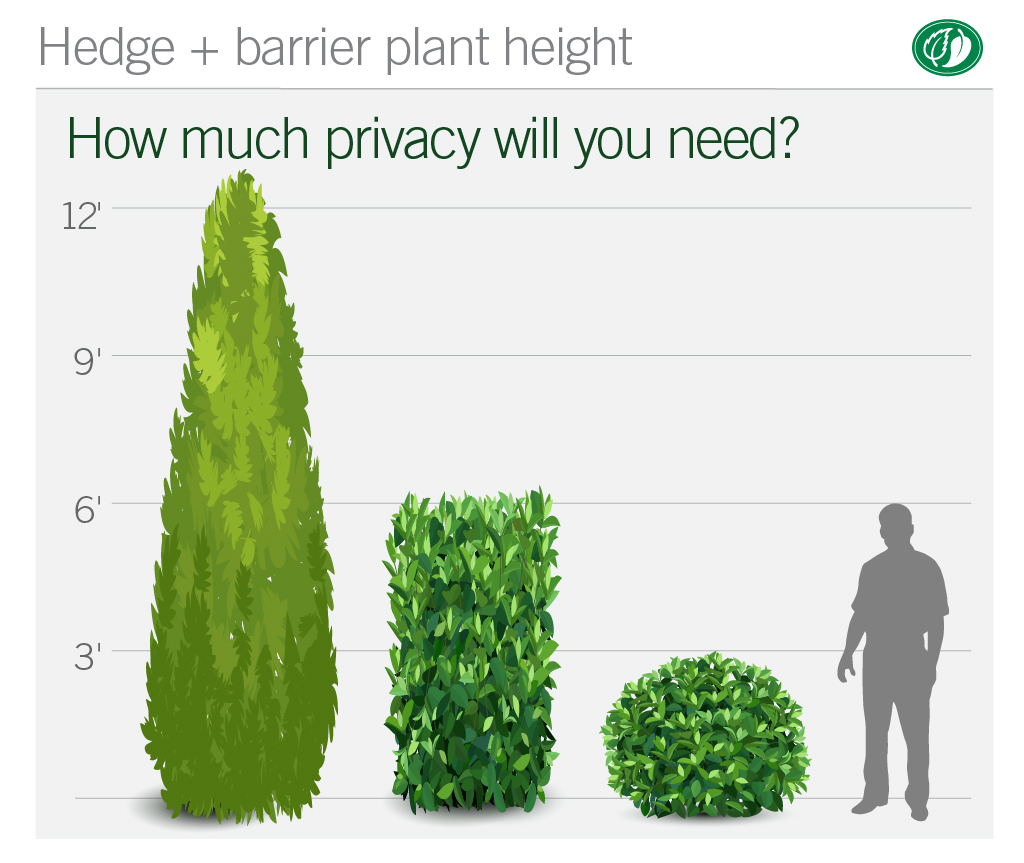
A hedge can add real beauty as well as a definition to your landscape. With a plant like Italian Buckthorn | Rhamnus alaternus ‘John Edwards’ for example, you can shear into a formal shape or a bushy one that creates a thick green wall between your client’s garden and the rest of the world.
A perennial bloomer like Camellia or California native Ceanothus loses its flowers but offers fresh, green spring foliage and blossoms in stunning colors. Flowering hedges can also attract birds and pollinators to a garden
A perennial bloomer like Camellia or California native Ceanothus loses its flowers but offers fresh, green spring foliage and blossoms in stunning colors. Flowering hedges can also attract birds and pollinators to a garden
Great Hedge + Screen Plants
Trying to list all of the plants that can be used effectively for creating privacy is nearly impossible.
However, we’ve assembled some of the most handsome, popular, and California natives that have a variety of mature heights. Bay Area Landscape Professionals that we work with often use these plants for privacy screens and green barriers.
However, we’ve assembled some of the most handsome, popular, and California natives that have a variety of mature heights. Bay Area Landscape Professionals that we work with often use these plants for privacy screens and green barriers.
Camellia sasanqua
Common name | Japanese Camellia
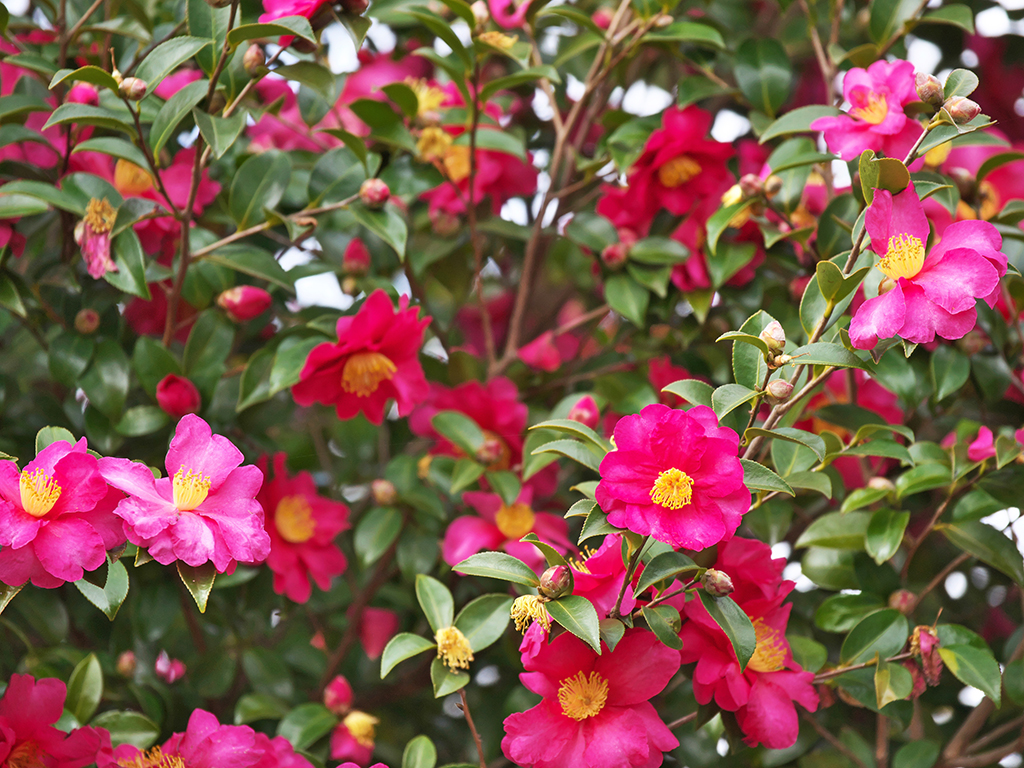
Despite their delicate-looking flowers, Camellia sasanqua are tough plants that bloom in shady areas with minimal care. They can reach 12′ in height with a somewhat narrower width. Beautiful flowers appear along the end of branches with very short stems between January and March. Mature plants have a relatively long bloom period of several months. Camellias can grow into a natural shape or be pruned more formally into a privacy hedge.
Carpinus betulus ‘Fastigiata’
Common Name | Hornbeam
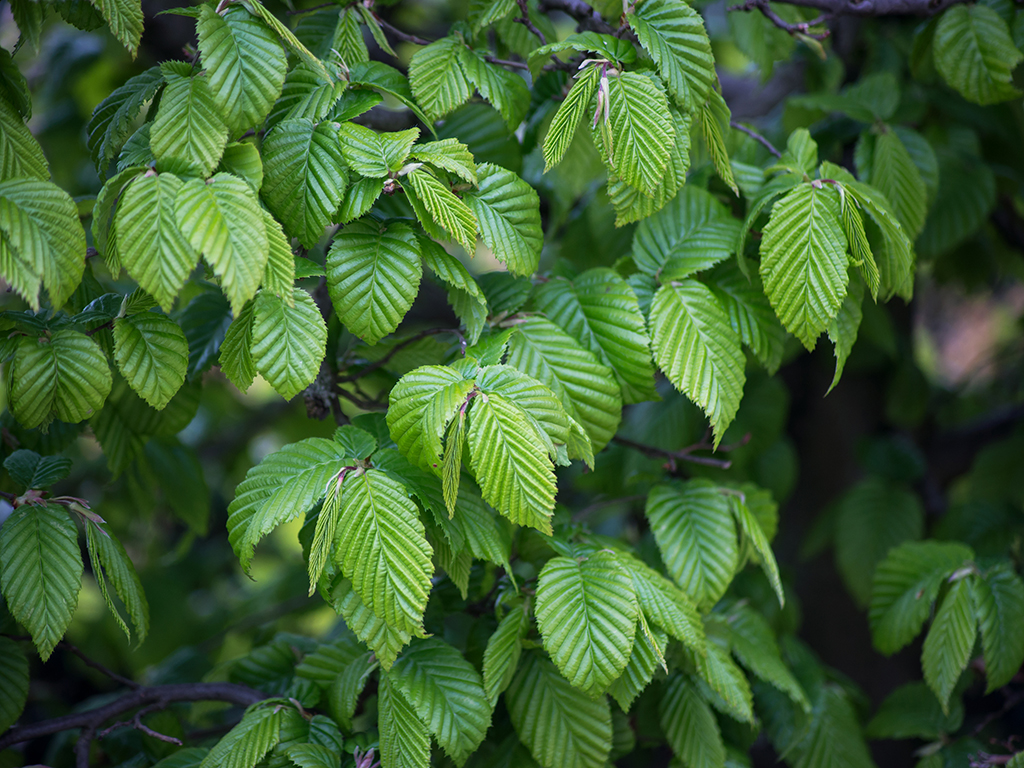
Carpinus betulus is commonly known as the European or common hornbeam. It is native to Western Asia and central, eastern, and southern Europe. As a deciduous small to medium-sized tree, it prefers some shade and moderate soil moisture for good growth. It can reach over 80′ and often has a fluted and crooked trunk. The bark is smooth and greenish-grey with foliage consisting of leaves with prominent veins that create a distinctive corrugated texture. When cut back, it creates dense foliage for sculpting hedges and privacy screens.
Ceanothus ‘Ray Hartman’

CA Native Common name | California Lilac
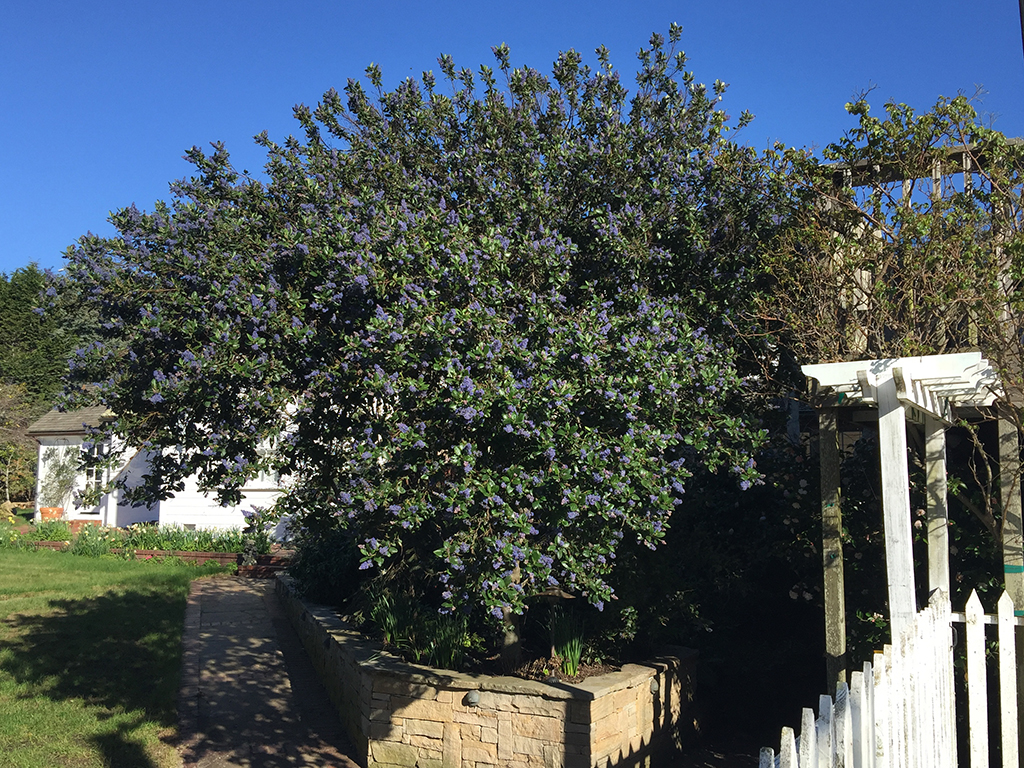
The ‘Ray Hartman’ form of Ceanothus is a CA native evergreen shrub that grows to 15′. Flowers are light to medium blue in flower spikes and the leaves are glossy and dark-green. It grows quickly and does well in heavy soils or sand with an upright form. It can be trained as a single trunk standard or low branched to work as a very effective hedge.
Cupressus macrocarpa
Common Name | Monterey Cypress
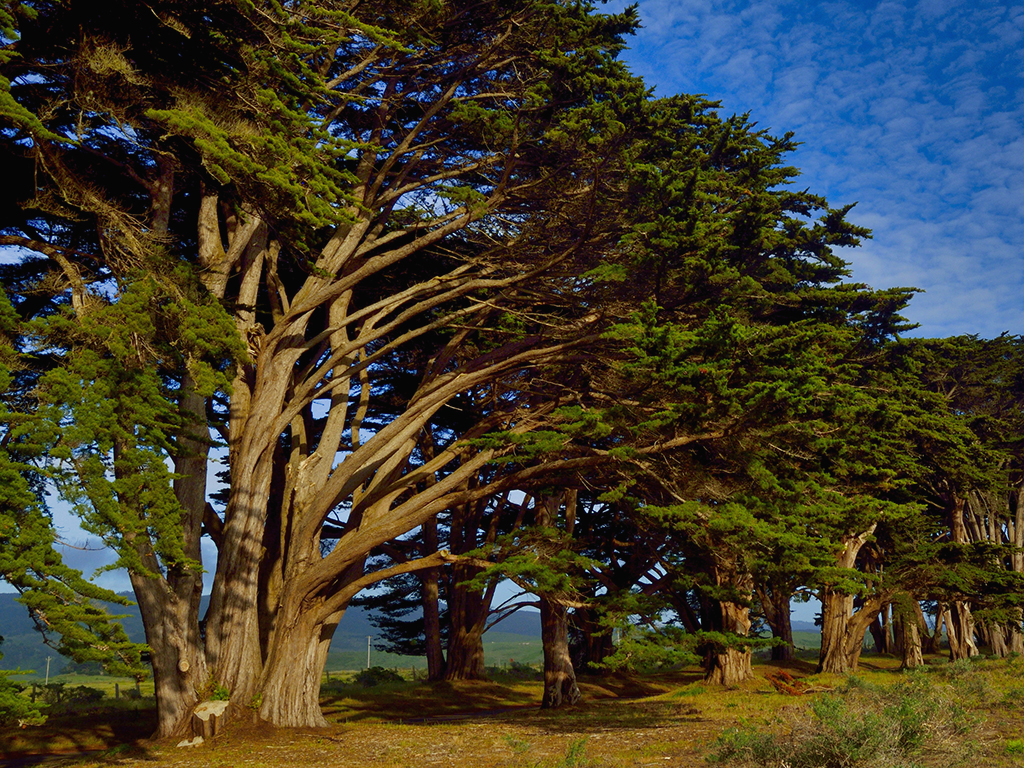
Cupressus macrocarpa is a medium-sized coniferous evergreen tree that grows to heights +130′ if allowed. However, it has a long life and works best as a privacy screen when kept sheered top to bottom. Foliage grows in dense sprays which are bright green in color and release a deep lemony aroma when crushed. The leaves are scale-like and are produced on rounded shoots.
Ficus microcarpa nitida
Common Name | Indian Laurel
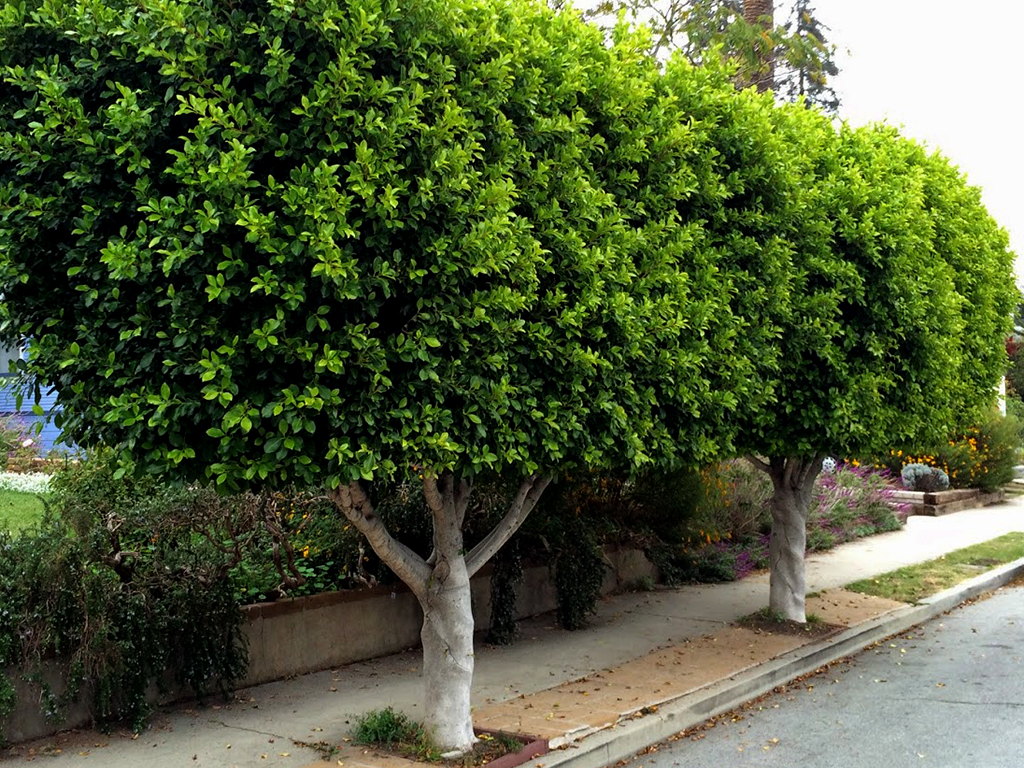
Ficus microcarpa is a broadleaf evergreen tall shrub/tree with smooth light-gray bark and about 2″ leaves attached to the stem by a pointed end with the other end rounded. It does well in our Bay Area Mediterranean climate and can grow to +40′ with an equal spread of the crown. Consider specifying this plant in a distinctive column form.
Laurus nobilis
Common Name | Sweet Bay
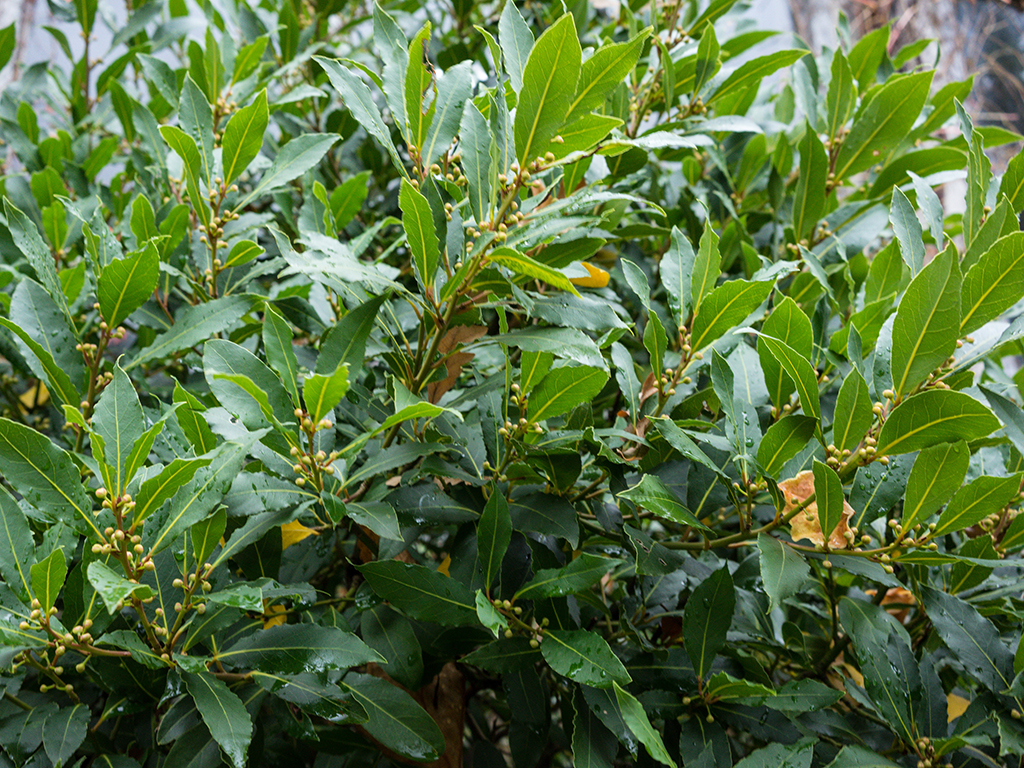
Laurus nobilis is a broadleaf evergreen tree or large shrub with green, smooth, and hairless leaves. As a hedge or privacy screen, this plant is an aromatic and culinary delight as the distinctive leaves can be used for seasoning in cooking. It’s native to the Mediterranean and can reach 60′. Commonly referred to as bay laurel or sweet bay, it’s slow-growing and may take several years to reach the desired height.
Ligustrum japonicum ‘Texanum’
Common Name | Waxleaf Privet
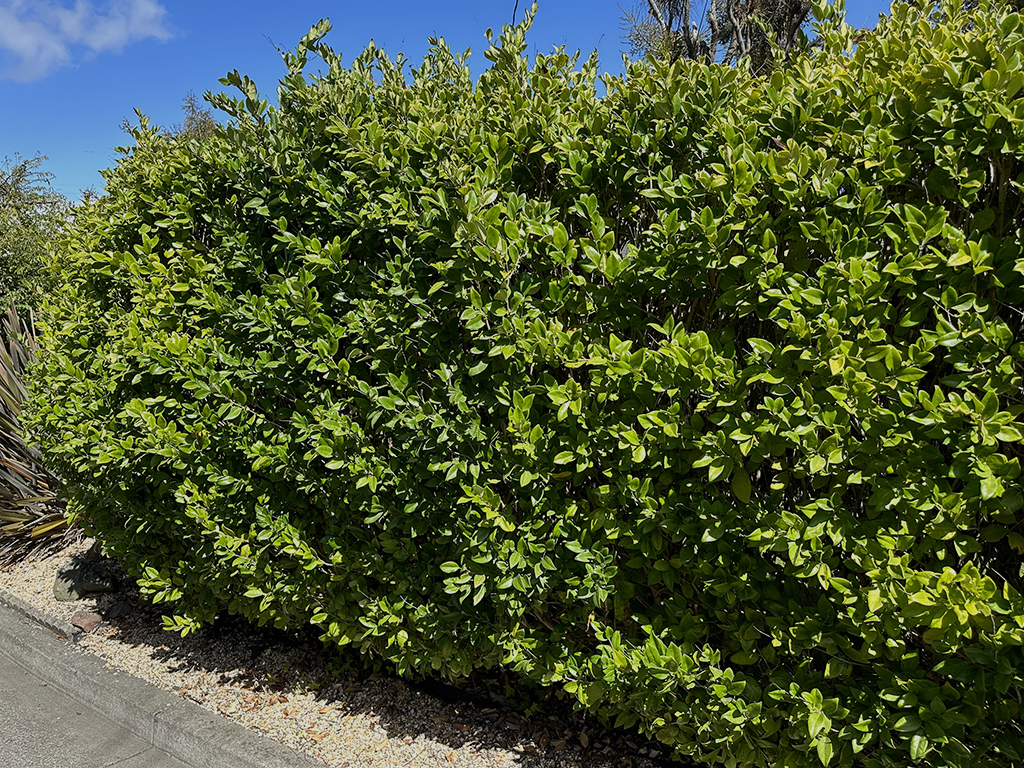
Ligustrum japonicum ‘Texanum’ is a slower-growing variety of species. It’s an evergreen dense, compact shrub with thick, round, waxy leaves that are glossy green above and whitish underneath. Fragrant bee-attracting white flowers bloom in late spring to early summer and are followed by blue-black berries. It prefers sun or light shade with regular water. It can also be trained to nearly any shape. So if you’re looking for evergreen hedge and screen plants, this is a great option.
Metrosideros excelsus
Common Name | New Zealand Christmas Tree
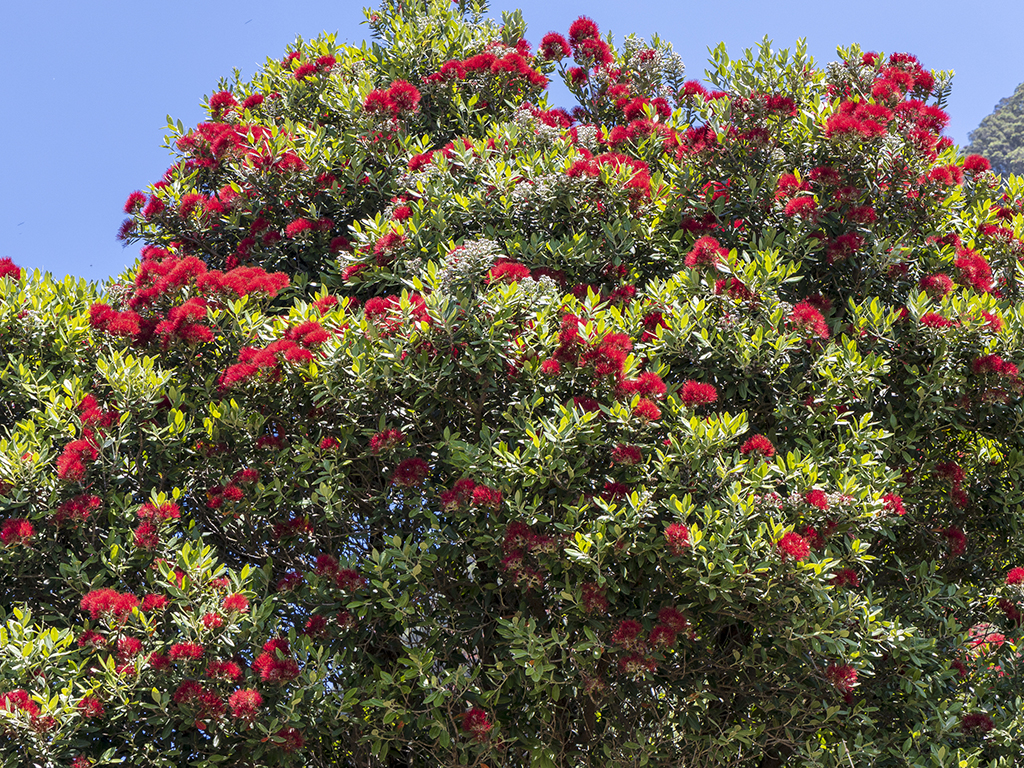
Metrosideros excelsus is an evergreen tree in the myrtle family that produces a brilliant seasonal display of red flowers. Renowned for its vibrant color and its ability to survive in rocky and challenging landscapes, it can grow to over 80′ high, with a spreading, dome-like form. As a multi-trunked spreading tree, it’s an excellent choice for coastal environments in need of a privacy screen or hedge as it is not affected by salt or ocean air.
“We install Metrosideros excelsus as a privacy barrier because it’s’ relatively deer-proof and drought-resistant. The opaque-colored grayish leaves make the surrounding foliage of the other plants really pop. And, as a multi with a little thinning out, it looks incredible at night with low-voltage lighting.”
Michael Moore | Masterpiece Gardens
Michael Moore | Masterpiece Gardens
Myrica californica

CA Native Common Name | Wax Myrtle
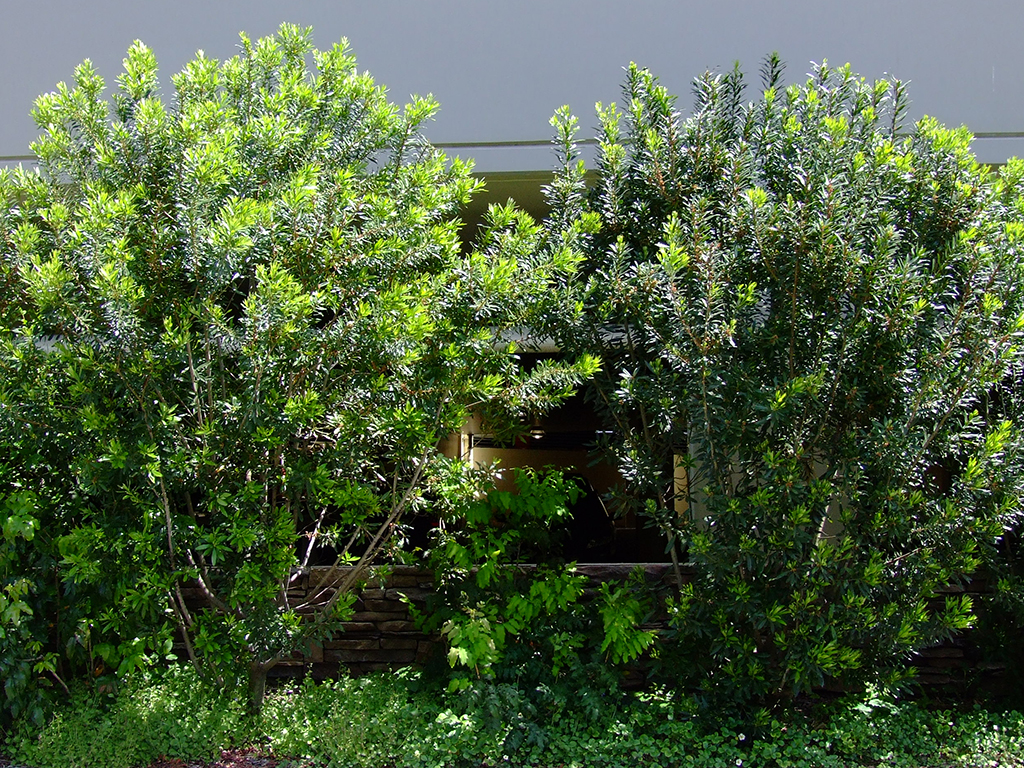
Myrica californica is an evergreen shrub or small tree native to the Pacific coast. It grows to over 30′ tall and has serrated, sticky green leaves that emit a spicy scent on warm days. The fruit is a wrinkled purple berry with a waxy coating that supports the common name wax myrtle. It does best in cool, moist coastal environments and can be used very effectively as a seaside windbreak.
Olea europea
Common Name | Olive
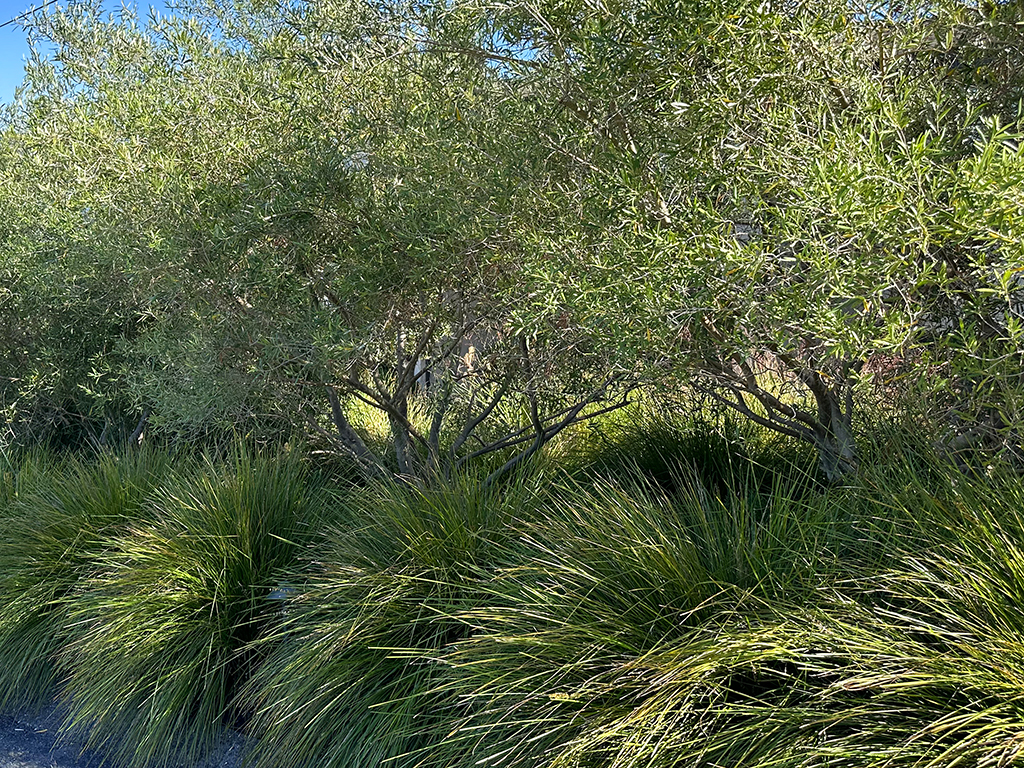
The olive tree, Olea europaea, is an evergreen, fragrant, multi-trunked tree or shrub that does extremely well in our Bay Area Mediterranean climate. It’s short and squat, and rarely exceeds 50′ in height. It features silvery green, oblong leaves with a typically gnarled and twisted trunk. Small, white, feathery flowers appear on the previous year’s wood. There are many cultivars to consider that don’t bear fruit for a screen or hedge.
Pittosporum eugenioides
Common Name | Lemonwood
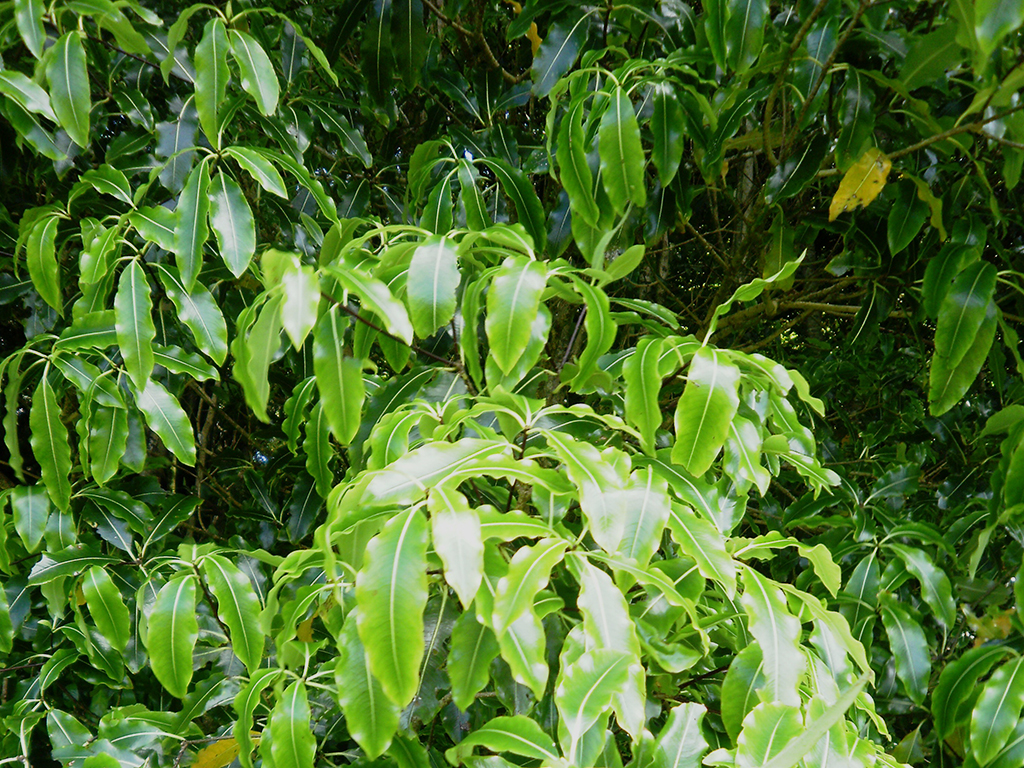
Pittosporum eugenioides is a species of New Zealand native evergreen tree that grows to 35′ tall. It is conical in form when young but become more rounded when mature. Leaves are mottled yellow-green with curly edges and a salient bright midrib and have a strong lemony smell when crushed. It’s an excellent hedging or screening plant that works well near water features and pools because it has minimal leaf litter. It’s also great in a windy position and provides a very effective barrier for more intolerant plants around it. If you’re looking for a beautiful, low-maintenance, green and textured backdrop with dense leaf clusters, this is an excellent choice.
Pittosporum tenuifolium
Common Name | Black Matipo
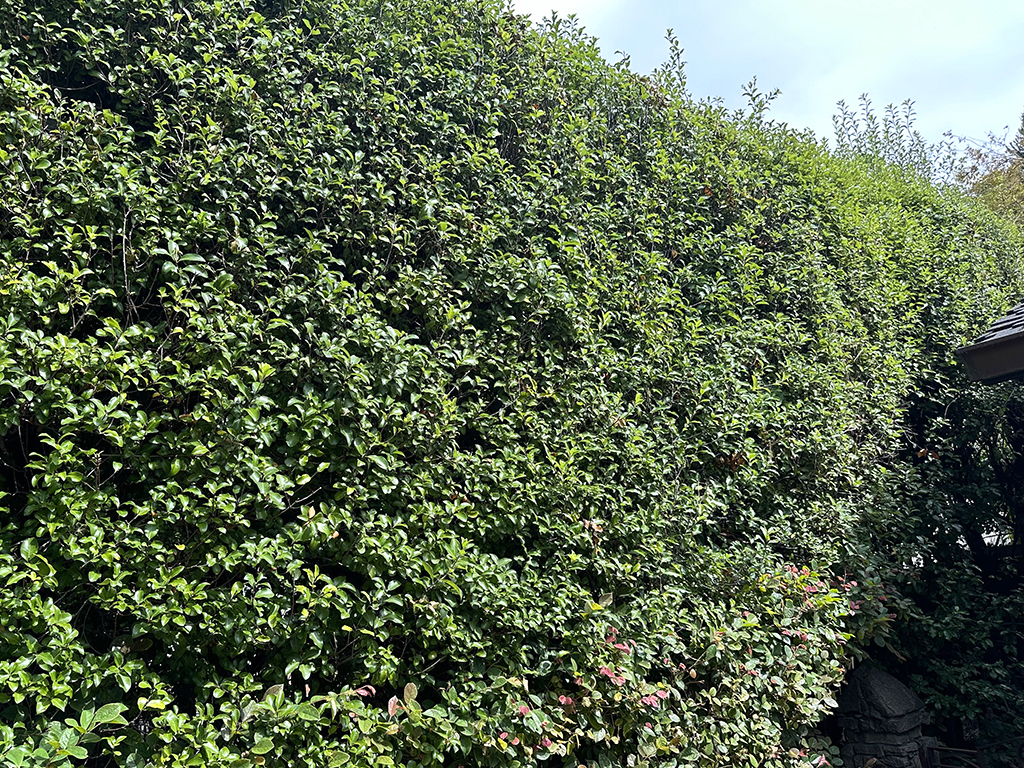
Pittosporum tenuifolium is a small evergreen tree that can reach heights to over 30′. It’s native to New Zealand and is commonly known as black matipo. It features distinctive black stems and dark trunk with foliage that can be purple, “silver” or variegated depending on the variety. It’s a fast-growing, very hardy privacy screen solution that tolerates difficult growing conditions, including dry soils and limited sun. Its flowers are a very dark reddish-purple, not showy and scented only at night with attractive fragrance. Pittosproum does well in coastal environments as well. If you consider this great plant, specify the bush form. Options include:
• P. t. ‘Sliver Sheen’
• P. t. ‘Wrinkled Blue’
• P. t. ‘Sliver Sheen’
• P. t. ‘Wrinkled Blue’
Podocarpus gracilior
Common Name | Fern Podocarpus
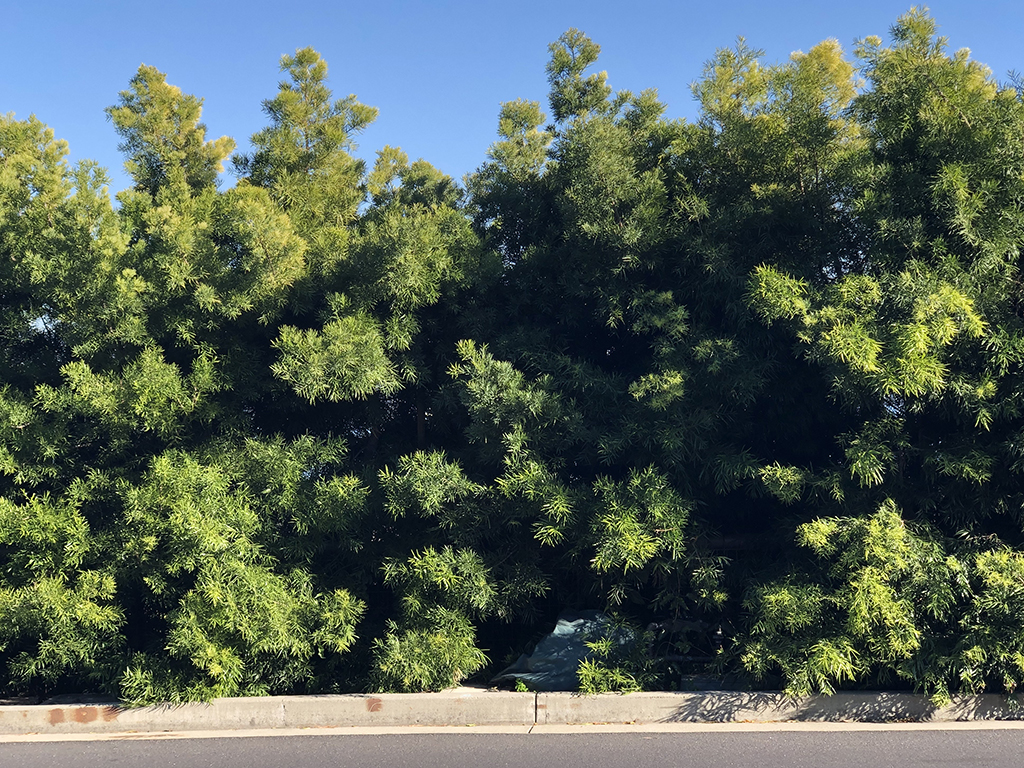
Podocarpus gracilior is a medium-sized tree that grows to 65-130′ tall. Its leaves are spirally arranged on mature trees with purple seeds that are frequently dispersed by birds that eat the fleshy seed coating. This is one of the most popular hedge and screen plants in the Bay Area.
Podocarpus henkelii
Common Name | Henkel’s Yellowwood
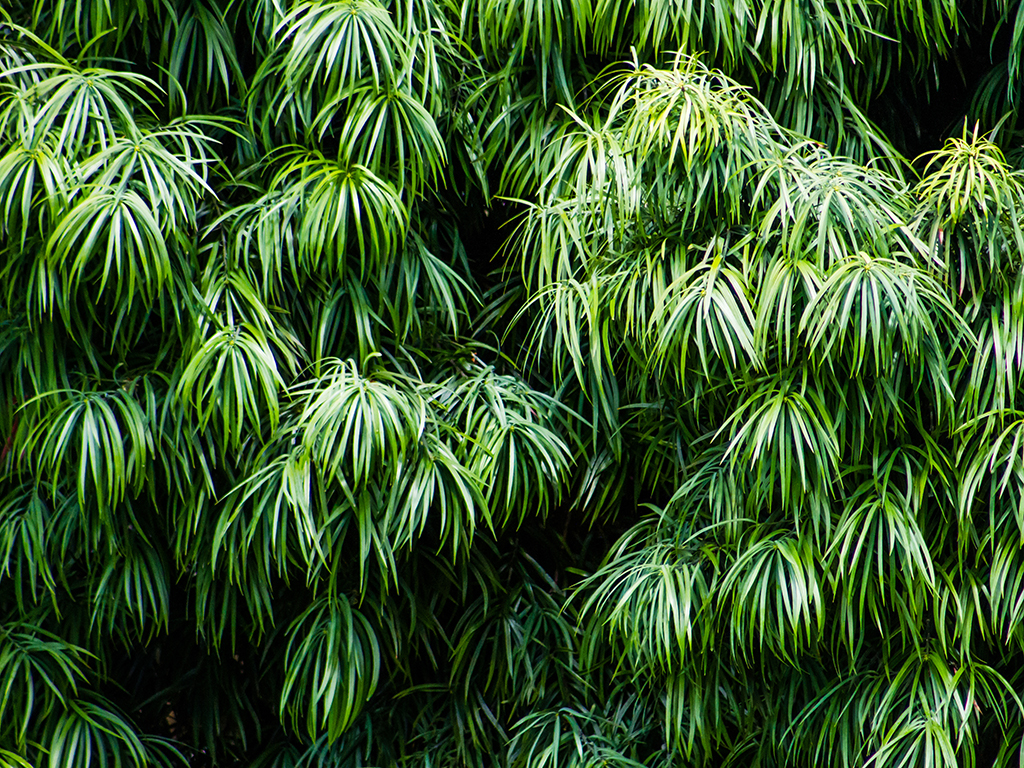
Podocarpus henkelii is an attractive ornamental tree, easily distinguished by its long, slender, blue-green, drooping leaves. It has a straight, well-formed trunk and naturally assumes a pyramid shape as it grows, eventually reaching 40′ tall. It’s frequently grown in gardens for its neat, attractive form and decorative foliage. As an incredibly long-lived plant, it can be pruned to change its shape. It’s also summer-dry tolerant but prefers moist soil.
Podocarpus macrophyllus
Common Name | Fern Pine
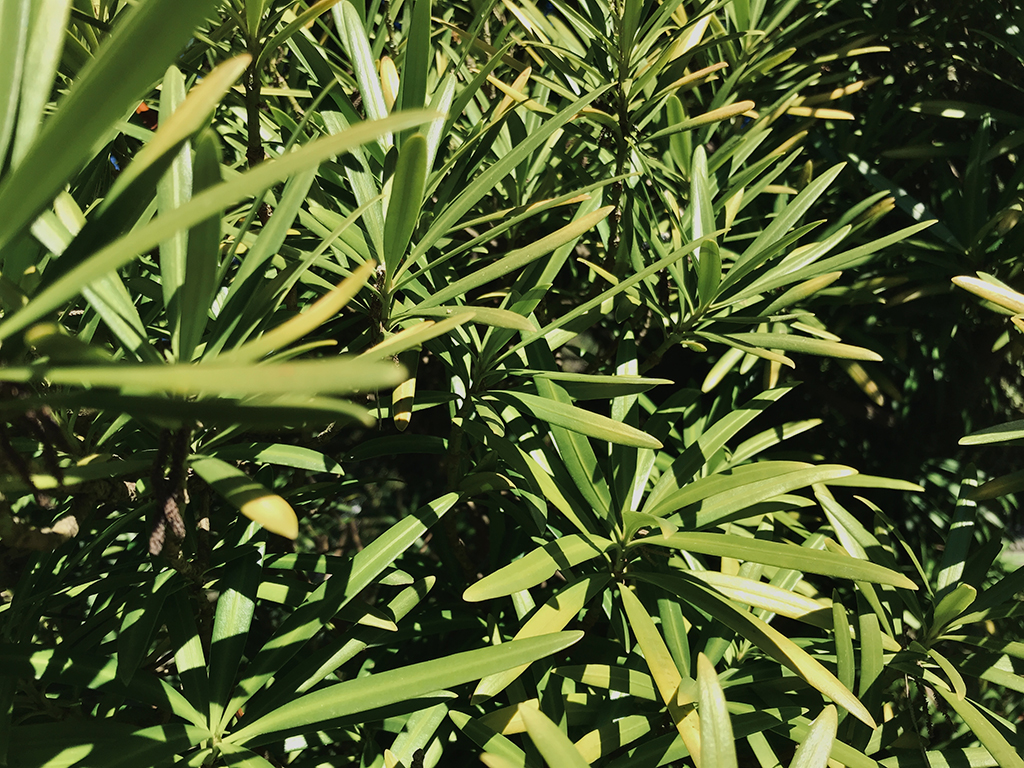
Podocarpus macrophyllus is a small to a medium-size evergreen tree, reaching 65’ tall. Its leaves are strap-shaped with a central midrib. Its traits are similar to Podocarpus henkelii.
Populus nigra ‘Italica’
Common Name | Lombardy Poplar
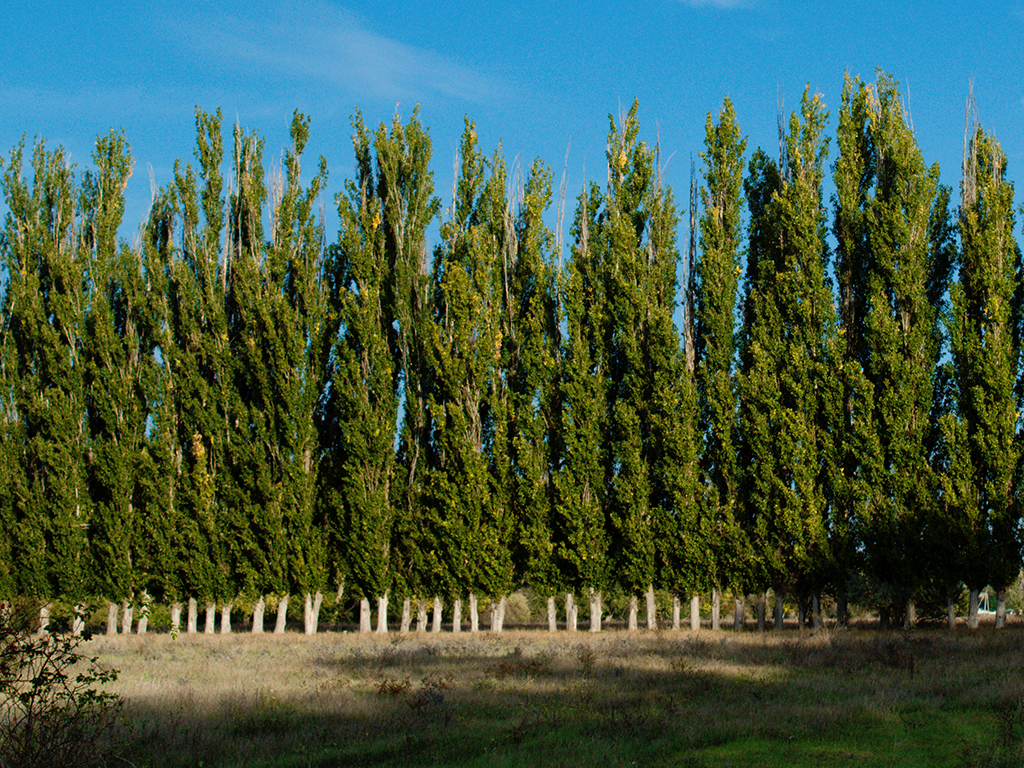
Populus nigra ‘Italica’ is a medium to large-sized deciduous tree, reaching 90′ tall. Leaves are diamond-shaped to triangular and are green on both surfaces. This tree is characterized by rapid growth and it does best in moist soil.
Prunus ilicifolia

CA Native Common Name | Hollyleaf Cherry
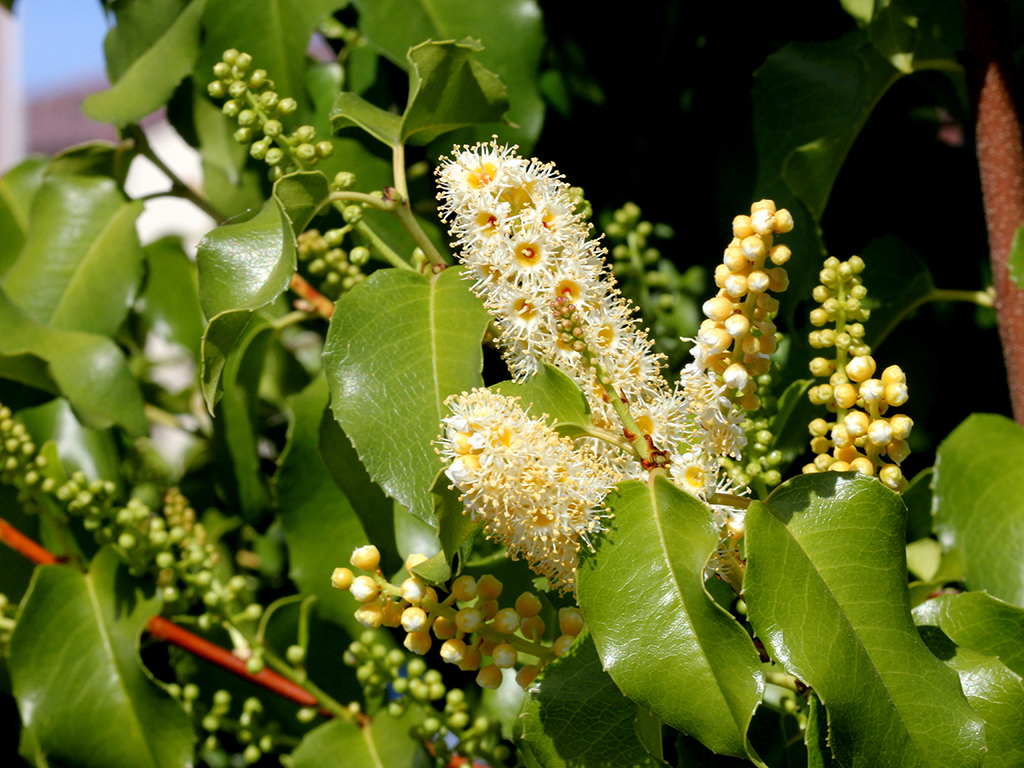
Prunus ilicifolia is an evergreen shrub and tree that produces edible cherry fruit with shiny and spiny toothed leaves similar in appearance to those of English holly. It grows up to 30′ tall, with thick, alternate, 1-2” leaves. It has small white flowers growing in clusters from March to May that bear purple to black fruit that is sweet, with a very thick pulp around a large single stone. As a handsome, showy plant, it attracts bees and tolerates pruning when used as a hedge. It also prefers full sun, loose open soil, and is drought tolerant. However, it needs regular watering when young.
Prunus laurocerasus
Common Name | English laurel
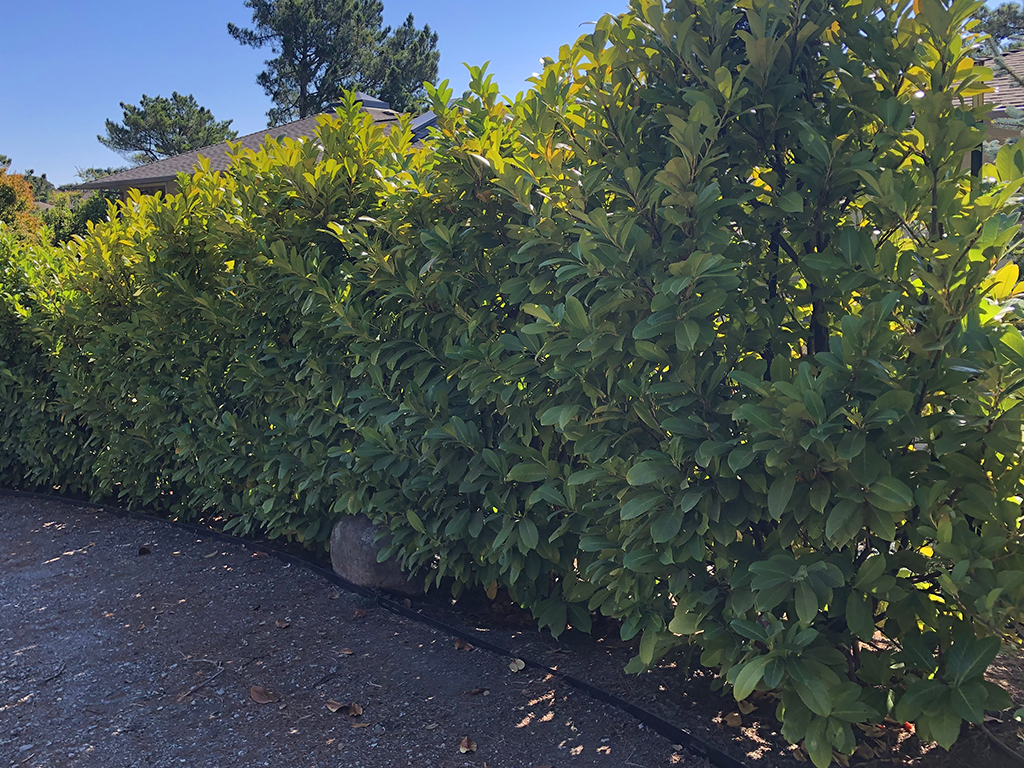
Prunus laurocerasus is an evergreen species of Prunus, native to regions in southwestern Asia and southeastern Europe. As an evergreen shrub or small to medium-sized tree, it can grow to nearly 50′. The leaves are dark green, leathery, shiny, with a finely serrated margin. As one of our favorite hedge and screen plants, it’s available in a bush and sometimes column form.
Prunus lusitanica
Common Name | Portuguese laurel
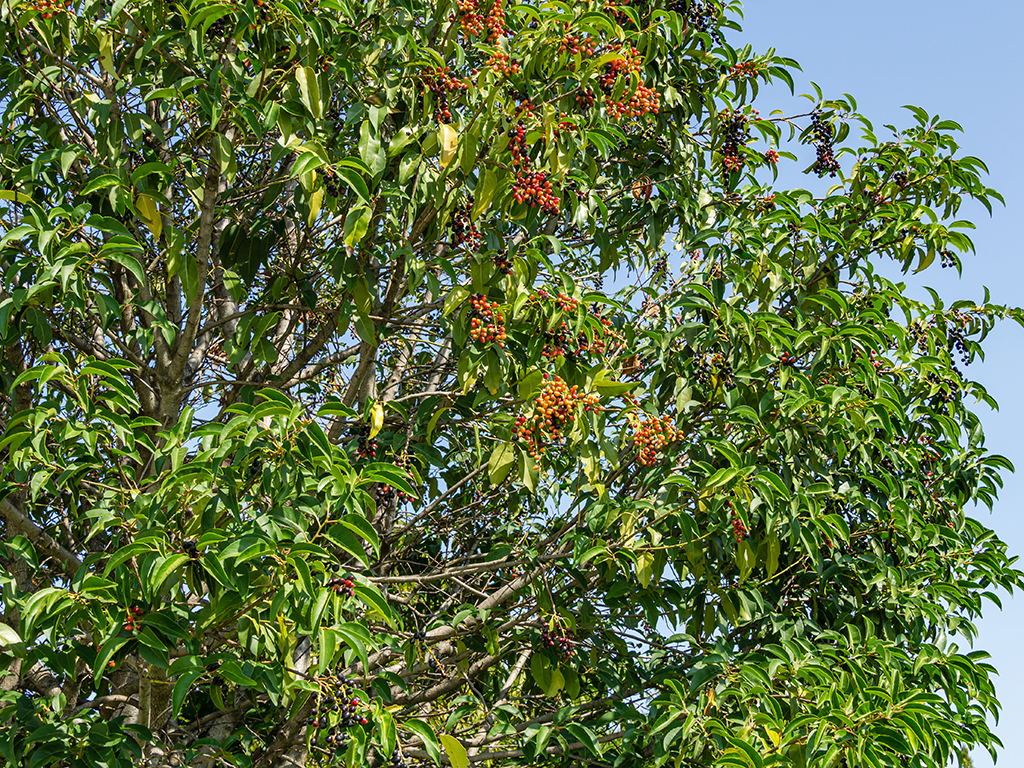
Prunus lusitanica is an evergreen shrub or small tree growing to 20′. The bark is blackish-brown and leaves are alternate glossy dark green above and lighter below. They resemble the Bay laurel and it’s often mistaken for one. This tree produces small cherry-like fruit that turns dark purple or black when ripe in late summer or early autumn.
Rhamnus alaternus ‘John Edwards’
Common Name | Italian Buckthorn

Rhamnus alaternus ‘John Edwards’ is a fast-growing, vertical, broadleaf, evergreen shrub with attractive 1.5″ glossy green leaves. It’s a great solution for a vertical evergreen screen that doesn’t require a lot of room at the base. It requires mostly sun in moderately moist soil and delivers a growth rate of 2′ per year. Under optimal conditions, it can double in size in about 3 years. It’s an excellent choice for a privacy screen in column form.
Sequoia sempervirens

CA Native Common Name | Coastal Redwood
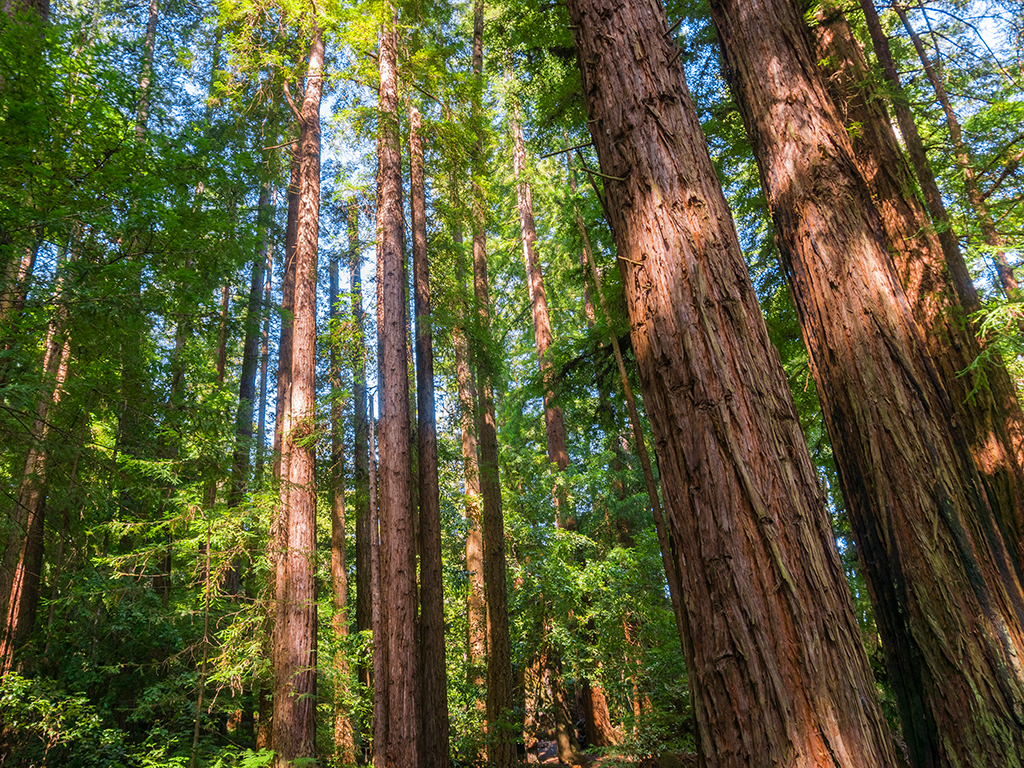
Sequoia sempervirens is an evergreen, long-lived, monoecious tree living for up to 2,200 years. This species includes the tallest trees on earth, reaching up to nearly 380′ in height. It’s native to coastal California and the southwestern corner of Oregon. This tree thrives in environments with wet winters and cool, foggy summers.
Thuja occidentalis ‘Emerald’
Common Name | Northern White-Cedar
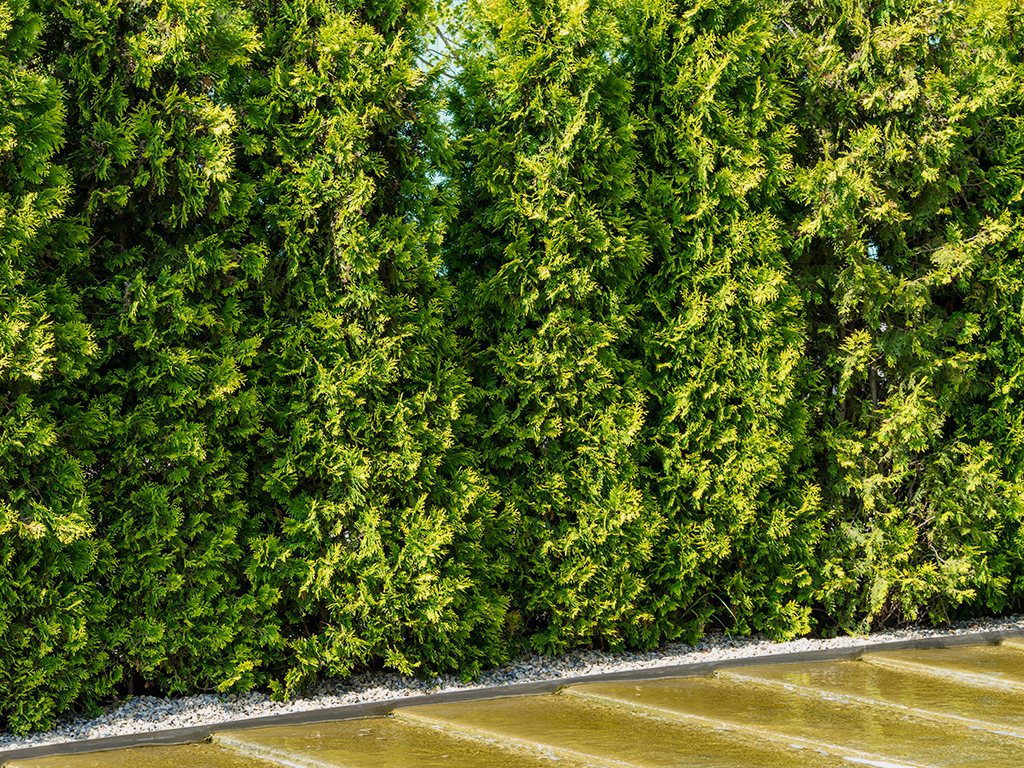
Thuja occidentalis ‘Emerald’ is a small or medium-sized tree, growing to a height of 50′ tall. The bark is red-brown, furrowed, and peels in narrow, longitudinal strips. The foliage forms in flat sprays with scale-like leaves and seed cones are slender, yellow-green, ripening to brown, with overlapping scales. It’s one of the finest evergreens for use as screening or a windbreak and is strong-rooted and virtually disease-free. Its uniform shape seldom needs pruning but responds well to shearing. It also thrives in heat and moist air.
Want to know more about hedge plants + privacy screen options?
If you want to discuss or learn more about hedge plants + privacy screen options for your project, feel free to contact any of our experts at Pacific Nurseries or call 650.755.2330.As both a grower and a plant broker, we’re ready to work with you to provide just the right plants that will make your landscape location a private sanctuary with attractive green barriers. We can also provide an Estimate for any item just by attaching your plant list to our convenient online estimate form.
What’s your favorite privacy screen plant?
Have you recently installed a great hedge or privacy screen plant? Share it with your social communities just by clicking on the sidebar on the left of the page or clicking on the social icon on your mobile device. We look forward to learning what’s worked well for you.As the Founder of Pacific Nurseries, Don Baldocchi gets satisfaction from knowing the Bay Area is greener and more beautiful by helping landscape professionals succeed. Email Don or give him a call at 650.755.2330.

